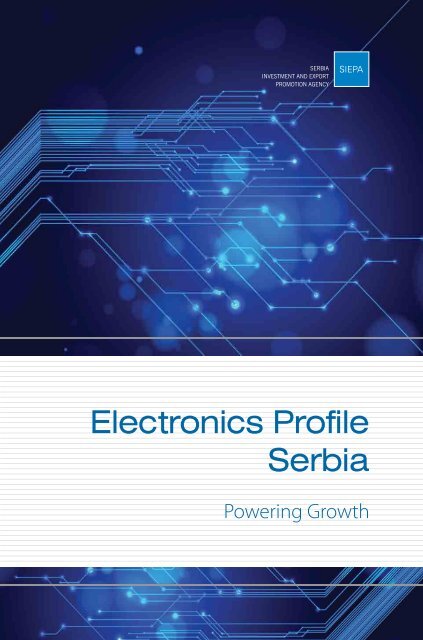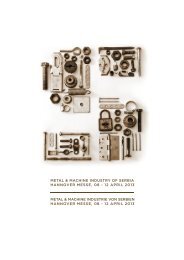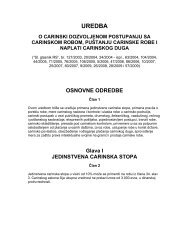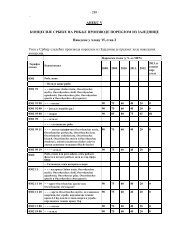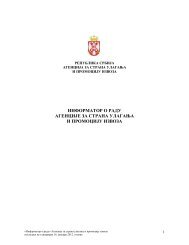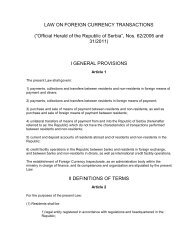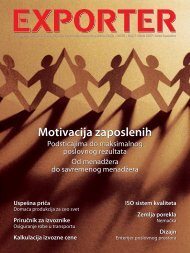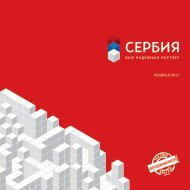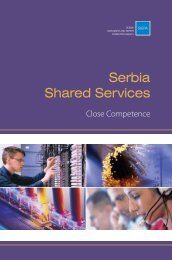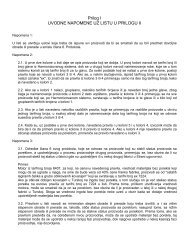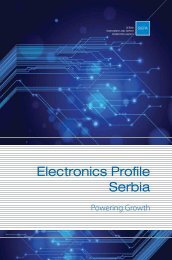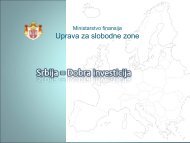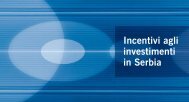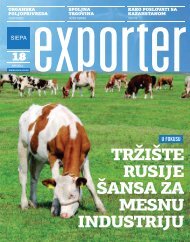Electronics Profile Serbia - Siepa
Electronics Profile Serbia - Siepa
Electronics Profile Serbia - Siepa
- No tags were found...
You also want an ePaper? Increase the reach of your titles
YUMPU automatically turns print PDFs into web optimized ePapers that Google loves.
<strong>Electronics</strong> <strong>Profile</strong><strong>Serbia</strong>Powering Growth
About <strong>Serbia</strong>2<strong>Serbia</strong> ID CardOfficial NameForm of StatePolitical StructureRepublic of <strong>Serbia</strong>Democratic RepublicPresidentUnicameral assembly with 250 seatsArea 88,361 km 2Population7.1 millionGeographic PositionSouth East Europe, central part of the Balkan Peninsula, at the intersection ofPan European Corridors N 0 . 10 and N 0 . 7BorderIn the east–<strong>Serbia</strong> borders Bulgaria, in the northeast–Romania, in the north–Hungary, in the west–Croatia and Bosnia-Herzegovina, in the southwest–Montenegro, and in the south–Albania and MacedoniaClimateTemperate continental, with monthly average temperatures ranging between0.7°C in January and 17.5°C in JulyOfficial Language <strong>Serbia</strong>nMain ReligionChristian OrthodoxOther Religions Roman Catholic, Islamic, Jewish, ProtestantMajor Cities Belgrade: 1,576,000; Novi Sad: 298,000; Nis: 250,000CurrencyDinar (RSD)GDP (2011)€32,993 millionGDP pc (2011) €4,543Time Zone Central European Time (GMT + 01:00)Internet Domain .rs3
Tradition of the <strong>Electronics</strong> Industry in <strong>Serbia</strong>Nikola Tesla<strong>Serbia</strong> is home to a rich tradition in the electronics industry, butthe story of this field in our country begins with Nikola Tesla, oneof the greatest pioneers and inventors in the field of electricity.Of his countless discoveries and contributions to science, Tesla'smost notable achievements include a forerunner to commercialelectricity, the alternating current (AC) system and important workleading to the invention of wireless communication and the radio.His colorful personality and groundbreaking achievements haverightfully been immortalized in science and popular culture alike,and it comes as no surprise that he is considered by many as themost important <strong>Serbia</strong>n of all time.<strong>Serbia</strong>’s electronics industry dates back to the post World War II period when smallscaleof manufacturing of radio devices began throughout the former Yugoslavia. Themain production centers of the electronics industry were in Slovenia and especiallyin <strong>Serbia</strong>. The biggest companies in this field were Iskra Kranj, Rudi Čajevac, RIZ and<strong>Electronics</strong> Industry Niš (EI Niš for short). These companies grew to become especiallylarge in the 1960s and 1970s. EI Niš was the largest of these: at the height of thiscompany’s peak it employed 28,000 people in over 50 factories throughout theformer Yugoslavia.The assortment of electronics products manufactured in <strong>Serbia</strong> grew as quicklyas the industry itself: Starting from the immediate postwar period of radio deviceproduction, companies in Yugoslavia moved into manfucturing consumer electronicsin the 1960s. In the subsequent decade, electronics production was also heavilyfocused on supplying the military. The 1970s also saw a rapid expansion in electronicsexports from Yugoslavia.This industry reached its peak in the 1980s: During this decade, Yugoslavia’selectronics industry was a $1 billion sector that employed around 100,000 people.About one quarter of these were employed in cutting-edge research and development.Companies in <strong>Serbia</strong> alone accounted for about half of the Yugoslav industry’sproduction and employees at this time. Every major foreign electronics company hadrepresentative offices in the country, while many firms worked under license to foreigncompanies. EI Niš produced television sets in cooperation with Philips. Manufacturersof electronic components for the military industry did so in accordance with standardsemployed in the United States.As was the case with most sectors, the 1990s in <strong>Serbia</strong> marked a period of sharpdecline for the electronics industry: The political problems and economic sanctionsimposed on <strong>Serbia</strong> during this decade had catastrophic consequences for the oncethrivingsector. By the mid-1990s, the size and profitability of <strong>Serbia</strong>’s electronicsindustry was less than 10% of what it was in the previous decade. The industry waslimited to serving only the <strong>Serbia</strong>n market. Reduced profits prevented local companiesfrom investing in new technologies.5
<strong>Electronics</strong> Industry in <strong>Serbia</strong> Today<strong>Electronics</strong> Industry in <strong>Serbia</strong> TodayAlthough the <strong>Serbia</strong>n electronics sector today is only a fraction of what it was at itspeak in the 1980s, recent foreign direct investment into the industry and variousstate-driven initiatives show that this sector has strong potential for future growth.There has been a steady influx of FDI into the sector - roughly €168 million - ever sincethe democratic changes of 2000; however, the most promising investments in thisfield have occurred in the past several years. This, coupled with the upcoming openingof several IT-electronics parks, illustrates that the best is yet to come for companiesin <strong>Serbia</strong>’s electronics sector.<strong>Electronics</strong> Exports from <strong>Serbia</strong>, 2008 - 2010 (€ millions)250,000,000200,000,000150,000,000100,000,00050,000,0002008 2009 2010The growing <strong>Serbia</strong>n electronics industry is a thriving, export-oriented sector thatonly figures to grow with the recent influx of foreign direct investment. Relative to 2008and 2009, exports from the industry in 2010 grew by 15% and 44%, respectively. The2009 economic crisis gap was surpassed swiftly in 2010 and, with new export-orientedprojects such as first Panasonic factory in <strong>Serbia</strong>, exports are expected to flourishfurther. Between 15 and 20 electronics companies export more than €1 million peryear. Many – such as Eaton Electric, ATB Sever, Gorenje, and Yura Corporation - areforeign-owned. On the other hand domestic brands are led by Fabrika AkumulatoraSombor, produce the globally-recognized “Black Horse” car starter batteries.One of the advantages of <strong>Serbia</strong> is the local production of high quality copperin mines of the Bor region. This enables highly-developed production of wires andcables. Leaders in the field are Polish-owned TF Kable and <strong>Serbia</strong>n companiesKablovi Jagodina and Novkabel. Recognizing this potential, Korean company Shinwonconstructed their brand new wire factory in City of Nis in 2011.In all, sub-sectors which dominate <strong>Serbia</strong>n exports are wires, cables, insulatedelectrical conductors, electrical circuits, and accumulators. Exports of these productsaccount for more than half of all electronics exports from the Republic of <strong>Serbia</strong>.Heating apparatuses, transformers, panels and consoles are also heavily representedin products produced in <strong>Serbia</strong> but sold abroad.With the entry of Slovenian company Gorenje, home appliances are becoming oneof the interesting outputs of <strong>Serbia</strong>n industry. Just four years after the establishmentof the factory, some 50 million euros of refrigerators are now being exported from<strong>Serbia</strong>. The government is looking to attract more investors in this labor-intensivesector by creating especially favorable conditions for potential investors.Company Amount exported in 2010 (€)Eaton Electric 40,472,696FAS – Fabrika akumulatora Sombor A.D. 39,528,335TF KABLE Fabrika kablova 29,837,892Kablovi Jagodina 9,093,379ATB Sever 8,057,461Gorenje Tiki 6,932,331Novkabel 6,318,300Yura Corporation 4,060,312ABS Minel Trafo 3,919,852Eurosax 2,175,557Telekom Srbija 2,127,866ICCE 2,043,577Metaloplastika 1,654,026Tehnoplast 1,432,718Metalka – Majur 1,414,499Primary <strong>Electronics</strong> Export Products, 2010 (in € million)Insulated wires and cables, other insulated electric conductorsElectrical circuitsup to 1000 V; connectors for opticalfibres...Electric accumulatorsHeating apparatusesElectrical transformers, static converters and inductorsElectric motors and generators (excluding generating sets)Discs, tapes, solid-state non-volatile storage devices, smart cards...Boards, panels, consoles, desks, cabinets and other basesParts suitable for electrical circuitTelephone sets and apparatus for the transmission or reception of voice...Other electrical apparatusesElectric sound or visual signalling apparatusElectric laser or other light or photon beams, brazing or welding machinesTransmission apparatuses; Monitors and projectorsElectrical insulatorsSource: <strong>Serbia</strong> Investment and Export Promotion Agency0 10 20 30 4067
Foreign Investments in the <strong>Electronics</strong> Industry in <strong>Serbia</strong>Foreign Investments in the <strong>Electronics</strong> Industry in <strong>Serbia</strong>From 2001 onwards, <strong>Serbia</strong> has witnessed the steady revival of the electronics industry.This has been primarily driven by a continual inflow of foreign direct investment. Thefirst significant investment in this sector was that of Austrian giant ATB Gruppe, whichpurchased Sever Subotica at the end of 2004 for €25 million. Undoubtedly the mostsignificant foreign investor in the sector is Slovenian home appliance company Gorenje.Since 2006, Gorenje has invested €50 million three separate locations in <strong>Serbia</strong> –Stara Pazova, Valjevo and Zajecar – and employed 1,150 workers. 2005 saw Germanelectronics giant Siemens acquire Loher GmbH and employ 500 workers and invest€13 million to establish a wind turbine manufacturing facility in Subotica. Siemenswill expand its <strong>Serbia</strong> footprint by investing a further €20 million and employing anadditional 250 full-time workers. Furthermore, Japanese electronics giant Panasonichas already begun production in planned to be a €13 million facility in Svilajnac incentral <strong>Serbia</strong>.Foreign Investments in <strong>Serbia</strong> by Sectors (in € million)Financial 3253.5Food & Beverage, Agriculture 2748.8Telecomunications 2245.0Retail 1968.2Real Estate 1866.0Oil & Gas 1474.4Automotive industry 1378.3Tobacco 911.0Construction 827.1Pharmaceutical 779.0Metallurgy & Metalworking 429.8Insurance & Pension 313.0Tourism 292.7Wood & Furniture 288.6Chemical 229.8Packaging 181.5Electrical & <strong>Electronics</strong> 167.8Clothing 119.8Textile 74.9Energetics 58.6Environomental Managemen & Recycling 56.3The government of <strong>Serbia</strong> is actively promoting the growth of this sector: Along withthe automotive and ICT industries, the electronics sector has been designated one ofthe priority sectors in <strong>Serbia</strong>’s National Development Strategy. This allows investors inthis sector to receive more favorable investment incentive packages. Companies in thisindustry have taken advantage of this fact: investments in the electronics industry arethird when it comes to the number of projects which have been approved for fundingand the fourth highest in terms of all investments in <strong>Serbia</strong> since 2000.Furthermore, numerous initiatives, including the promotion of IT and Research andDevelopment parks throughout the country and the founding of an electronic systemscluster, will propel the sector even further. Within a few years, investors will be able topurchase land and facility space in areas specially designed with their needs in mindin Belgrade, Novi Sad, Kragujevac, Indjija, and Nis. The recently-formed embeddedcluster encourages further collaboration between companies from the industry andpublic sector and educational institutions.As it does for investors in various fields, <strong>Serbia</strong> offers an excellent array of featuresfor electronics manufacturers: low operating costs, free trade possibilities, financialincentives, labor availability, and investment security which is fully guaranteed by theLaw on Foreign Investment. With free trade agreements with the Russian Federationand Turkey on one side, and the European Union on the other, <strong>Serbia</strong> is the onlycountry in Europe which offers customs-free export opportunities for electronics toeach of these high-growth markets.“We were delighted to find such an abundance of highly qualified workforceat such proximity to the European Union market. <strong>Serbia</strong> has invested a lotof attention to the road and industrial infrastructure as well as the customssystem making it possible to establish manufacturing operations and OEMsupply at a very fast rate. This was essential to us since the production of ourclients in Europe was also growing rapidly and we needed to maintain ourposition as key supplier. <strong>Serbia</strong>n Government is very strongly supporting theindustrial development of the country making it very easy and profitable forforeign investors to locate there.”Mr. Jongwoo NamGeneral Manager, Yura Corporation d.o.o.“Due to competitive total operational costs and increase in Russianconsumer market for major appliances, Gorenje decided to initiateproduction of several key products in <strong>Serbia</strong>.”Mr. Mirko LesnikGeneral Manager, Gorenije Tiki89
Foreign Investments in the <strong>Electronics</strong> Industry in <strong>Serbia</strong>Largest Foreign Investmentsin the <strong>Electronics</strong> IndustryATB - Sever SuboticaMuehlbauerEatonGorenjeDanubeSavaSomborŠabacMali ZvornikDrinaSuboticaSentaBeèejVrbasSremska MitrovicaSavaSiemensKikindaZrenjaninNovi Sad VršacBelgradeSmederevoDanubeValjevoSvilajnacBorDunkermotorenDräxlmaierGorenje TikiPanasonicName Country Municipality Value Jobs CompletedSiemens LoherElectro Germany Subotica 33.0 750 2011ATB - Sever Subotica Austria Subotica 25.0 1000 2004TF Kable - Fabrika kablova Zajecar Poland Zajecar 25.0 560 2007Gorenje Slovenia Valjevo 30.0 600 2007Gorenje Tiki Slovenia Stara Pazova 16.0 400 2010Vossloch-Schwabe (Panasonic) Germany Svilajnac 13.0 400 2010Gorenje Home Slovenia Zajecar 8.0 300 2011Photon Optronics Germany Nis 6.3 70 2010Muehlbauer Germany Stara Pazova 4.0 100 2007Eaton/Moeller Germany Sremska Mitrovica 3.8 260 2007Sagemcom France Nis 3.3 203 2011Elrad Slovenia Vlasotince 2.3 228 2007Gruner 1 Germany Vlasotince 2.1 200 2007Engel Spain Nis 2.0 62 2001El France Nis 1.1 51 2011Dunkermotoren Germany Subotica 1.0 50 2011Yura CorporationUžiceKraljevoJagodinaKragujevaParaæincZajeèarTF KablePrijepoljeKruševacProkupljeNišPirotGrah AutomotiveLeoniPeæLeskovacKosovska MitrovicaPrištinaVranjePrizrenGorenje HomeYura Corporation“With start of WEG production in <strong>Serbia</strong>, we expect faster and easierapproach to EU, Middle East and Africa markets, what was our maingoal from the beginning.”Ms. Tijana KatalinicMarketing Director, WEG TechnologyYura CorporationGrunerElrad“<strong>Serbia</strong> fulfills a lot of preconditions for labor-intensive JIT productionwith available labor force, good infrastructure and not forget the strongand highly qualified support of the government and local authorities.”Mr. Peter Prohaskaformer General Manager, LEONI <strong>Serbia</strong>11
Success StoriesInvestment: 50M €Employees in <strong>Serbia</strong>: 1300Government support: Supported by 5M € grantStart of operations in <strong>Serbia</strong>: 2006Investment: 33M €Employees in <strong>Serbia</strong>: 750Start of operations in <strong>Serbia</strong>: 2003Gorenje Group was established in 1950. The group’s core business consists ofproduction and sales of household appliances, home interior items and trade andservices. In 2010, Gorenje Group was present in more than 70 countries, employed11,174 employees and achieved consolidated revenues of EUR 1.38 bn.In <strong>Serbia</strong>, Gorenje has invested around 50 million EUR to establish factories inValjevo, StaraPazova and Zaječar. In these factories, Gorenje produces refrigerators,freezers, cooling equipment in Valjevo; heating appliances in Zaječar; and washingmachines and driers in StaraPazova. In total, the company employs 1300 workersin <strong>Serbia</strong>. Gorenje received a total of 5 million EUR in grants from the <strong>Serbia</strong>ngovernment – this accounts for 10% of the company’s total invested amount in <strong>Serbia</strong>.Furthermore, for investment in Zaječar, the <strong>Serbia</strong>n government has agreed to buildfull transportation and electrical infrastructure.The other key reasons why Gorenje decided to come to <strong>Serbia</strong> are:• Ability to export to the Russian market under a preferential export regime - 1%tax rate for importing products from <strong>Serbia</strong>, compared to approximately 20% forimporting from the EU;• Flexible logistics and proximity to export markets (EU, CEFTA and Russia);• Experienced and cost-effective labor (cost of labor one third of similar offeringin Slovenia).Investment: 7.5M €Employees in <strong>Serbia</strong>: 150Government support: Supported by 750,000 € grantStart of operations in <strong>Serbia</strong>: 2011WEG Group was established in 1996. WEG Technology works mostly as a wholesalerof brown goods, white goods and small home appliances for other brands. WEG Groupconsists of 7 sales representatives worldwide. Its Finance & Distribution Centers arelocated in Milan and Belgrade and its sourcing offices are in China - Hong Kong, andShenzhen. Most of WEG’s revenues are generated in the Eastern European marketssuch as <strong>Serbia</strong>, Bosnia, Croatia, Romania and Bulgaria.In order to fulfill its aggressive strategy to rapidly penetrate the EU, Middle East andAfrican markets, WEG decided to shift some production capacity from China to <strong>Serbia</strong>.This is why WED invested 7.5 million EUR in production facility near Belgrade with 150workers. To support WEG’s project, the government of <strong>Serbia</strong> provided 750,000 EUR(5,000 EUR per new employee) non-refundable grant.For more than 125 years, Siemens has been one of the leading providers of equipmentin <strong>Serbia</strong> (ex-Yugoslavia) in its three main business divisions - industry, energy andhealthcare. In 2005, Siemens acquired LoherElektro in 2003 and invested 13M EURfor its plant for large drives for wind and solar power plants in the city of Subotica.LoherElektro created 600 new jobs in northern part of <strong>Serbia</strong> as part of this investment.Every month in the factory, 280 generators for wind turbines are produced for a numberof well-known companies such as GE Wind, Nordex, Repower, Fuhrlander, Gamesa,Ecotehnia, Vestas, Eviag and many more.At the beginning of 2011, Siemens announced the expansion of its productioncapacities in <strong>Serbia</strong> until 2013. In this three year plan, Siemens will invest an additional20M EUR in new plant which will produce 400 ofthe latest generation of generatorsdeveloped by Siemens Development Center per month. An 150 additional employeeswill be hired as part of this plan.Investment: 3.8M €Employees in <strong>Serbia</strong>: 1000Government support: Supported by 520,000 € grantStart of operations in <strong>Serbia</strong>: 2006Eaton electric d.o.o. in Sremska Mitrovica is an assembly plant of Miniature CircuitBreakers (MCB) and related products and is a part of the Power DistributionComponent Division production network of Eaton Electrical Sector EMEA. Eaton’splant is located in northwest <strong>Serbia</strong> in SremskaMitrovica in Vojvodina. The factorybecame part of the “Eaton family” in 2008, when Eaton acquired Moeller. TheSremska Mitrovica plant produces the latest generation of protective switchgearsthat provides maximum operational safety and protection of people and electricalsystems in all various kinds of buildings.In 2006, Moellercompany, which was later purchased by Eaton, decided to opena Greenfield production facility in SremskaMitrovica because it saw that the localdemand was growing quickly. The sales office in Zemun in Belgrade was foundedat the beginning of 2006 and production in SremskaMitrovica was established inMay 2006. In 2008, Eaton Corporation acquired Moeller and proceeded to expandlocal operations.12 13
LaborFaculty ofTechnical SiencesNovi SadSomborSuboticaBeèejSentaKikindaTechnical Faculty“Mihajlo Pupin”ZrenjaninDanubeLabor<strong>Serbia</strong>’s labor force combines exceptional work efficiency with sizable labor supply.With its unique advantage of high quality and low costs, it is one of the key factors inreaching a strong business performance.The quality of the local labor force is best reflected in robust industrial productivity,rising at an 11% rate between 2004 and 2008. Labor supply in <strong>Serbia</strong> in 2012comprises of 665,474 unemployed and that number annually increases by 42,000university and 2-year college graduates and 74,000 high school graduates. Technicaleducation is particularly strong–high school students are among the best performersat world contests in natural sciences, while <strong>Serbia</strong>n engineers are well-knownworldwide for their expertise. In addition, <strong>Serbia</strong> boasts the highest English speakingproficiency in Eastern Europe. Management education has also been improvedwith an introduction of joint graduate and post-graduate courses organized by localuniversities and renowned Western business schools.Faculty ofTrafic and TransportEngineeringBelgradeFaculty ofTechnology andMetallurgyBelgradeTechnical FacultyÈaèakFaculty ofMechanical EngineeringKraljevoTechnical FacultyNovi PazarSavaVrbasSremska MitrovicaDrinaŠabacMali ZvornikUžiceSavaValjevoPrijepoljeÈaèakZrenjaninVršacNovi SadBelgradeKraljevoNovi PazarPeæKragujevacPrizrenSmederevoKruševacKosovska MitrovicaPrištinaJagodinaParaæinDanubeLeskovacVranjeNišBorZajeèarPirotFaculty ofElectrical EngineeringBelgradeFaculty ofMechanical EngineeringBelgradeFaculty ofMechanical EngineeringKragujevacFaculty ofMechanical EngineeringNišFaculty of<strong>Electronics</strong> EngineeringNiš<strong>Serbia</strong>n Labor Chart 2012Averge net salary in <strong>Electronics</strong> Industry 295 €Contributions paid bu employerPension and disability insurance 11.00%Health insurance 6.15%Unenployment insurance 0.75%Contributions paid by the employeePension and disability insurance 11.00%Health insurance 6.15%Unenployment insurance 0.75%Personal Income Tax 12.00%Average total salary cost in <strong>Electronics</strong> Industry 405 €Labor lawWorking week40hOvertime8h/week 4h/dayN o of shifts max 3Labor supplyEmployed people* 2,299,068Unemployed people* 665,474Unemployement rate* 22.4%Source: Statistical Office of the Republic of <strong>Serbia</strong> (Jan-Oct 2012) / (*Oct 2012)Cluster InitiativesEmbedded.rsAn Integrated Electronic Systems Cluster, “Embededd.rs”, is an initiative launched in2008 with the goal of promoting and strengthening embedded technologies (integratedelectronic systems) in the Republic of <strong>Serbia</strong>. One of the main aims of this cluster is tostrengthen connections between companies in this field and scientific institutions. Sofar, Embededd.rs has gathered 9 companies and 3 research institutions.More information: www.embedded.rsNis Cluster of Advanced TechnologiesFounded by 19 companies involved in electronics manufacturing and IT, the NisCluster of Advanced Technologies provides operational and administrative support toits members, promotes <strong>Serbia</strong> and the City of Nis as a hub of IT and manufacturingactivity, and advances cooperation between its member companies and localeducational and research institutions. It regularly cooperates with the City of Nis,the Electrotechnical University of Nis, the Nis Chamber of Commerce and the NisBusiness Incubator.More information: www.nicat.irvas.co.rs1415
Logistics and InfrastructureLogisticsandInfrastructureAs a logistics base, <strong>Serbia</strong> is a perfect location for a company wishing to efficiently serveits EU, SEE or Middle Eastern customers. It borders the EU at the Hungarian, Bulgarian,and Romanian state lines, while offering benefits of working outside the EU. Owingto its excellent strategic position on the geographic borderline between East andWest, <strong>Serbia</strong> is often referred to as a gateway of Europe. Two important Europeancorridors, N 0 7 – River Danube and N 0 10 – the international highway and railroad,intersect on <strong>Serbia</strong>n territory, providing excellent transportation connections withWestern Europe and the Middle East. By using well developed road connections,a shipment from <strong>Serbia</strong> can reach even the remotest parts of Europe in less than72 hours. The transport of goods via railroads is highly cost effective. Through theCorridor N0 10, <strong>Serbia</strong> offers access to major European destinations. <strong>Serbia</strong> boastsa great potential to grow into the logistics hub of South East Europe. In order tofurther upgrade the country’s road and railway networks, roughly €4 billion will beinvested in its modernization over the coming years.The natural availability of hydropower and coal in <strong>Serbia</strong> results in the lowest priceof electricity in Europe, averaging just 0.05 €/kWh. The gas pipeline covers around50% of the major cities in <strong>Serbia</strong> but further boost will come from the new SouthStream Pipeline that will transport Russian natural gas across Black Sea, Bulgariaand <strong>Serbia</strong> into the mainland Europe. The 63 million m 3 per year pipeline is due to becompleted by 2015.Transportation InfrastructureLength of road network40,485 kmLength of railway network3,809 kmLength of navigable routes959 kmNumber of river ports 12Number of intrenational airports 2Average Utilities CostElectricity0.05 €/kWhCROATIADanubeSavaBOSNIA ANDHERZEGOVINAHUNGARYSomborDrinaSuboticaVrbasSremska MitrovicaŠabacMali ZvornikUžiceSavaBeèejMONTENEGRONovi SadValjevoPrijepoljeSentaKikindaZrenjaninBelgradeKraljevoPeæKragujevacVršacSmederevoKruševacKosovska MitrovicaPrištinaJagodinaParaæinDanubeLeskovacVranjeROMANIANišBorZajeèarHighwayMotorwayRailroadAirportRiver portBULGARIAPirotGas 0.42 €/m 3Water 0.20 €/m 3Average Production Hall CostBuilding 400 €/m 2Renting 5 €/m 2ALBANIAPrizrenMACEDONIA16
Free TradeFree TradeArrangementsExternally, <strong>Serbia</strong> can serve as a unique base for duty-free tradeon a market of1 billion people including:• The European Union,• The United States of America,• The Russian Federation,• Turkey,• South East Europe,• The European Free Trade Agreement states,• Kazakhstan, and• Belarus.<strong>Serbia</strong> is the only European country with free trade arrangements with bothEuropean Union and Russian Federation. Not only it bridges East and West but it alsoserves as a service hub for Euro/Asian market. The free trade agreements with EU,EFTA, CEFTA and Turkey allow mutual accumulation of origin, as do the agreementswith Russia, Belarus and Kazakhstan.Only two restrictions in free trade still exist: when importingfrom EU to <strong>Serbia</strong>,there are still customs duties that will gradually be reduced to zero by 2014, while theagreement with Russia does not exclude any electronics productsNon EU CountriesEU CountriesCEFTAEFTARussia, Belorussia & KazakhstanTurkeyFree Trade Zones and Inward ProcessingExporters in <strong>Serbia</strong> do not have to be concerned with import duties and VAT onmaterials from EU or any other country in the world. In order to stimulate exportoriented production, Republic of <strong>Serbia</strong> provides custom and VAT free import ofmaterials through the Inward Processing procedure. The general permission for InwardProcessing is obtained once a year but even further simplification of the procedure canbe gained by operating in one of the Free Trade Zones. Free Trade Zone is consideredto be outside the custom system and all goods bound for factories inside them arecustom and VAT free.Market Trade Regime N o . of InhabitantsEuropean Union Interim Trade Agreement 494,070,000USA Generalized System of Preferences 302,558,000Russia, Belarus & Kazakhstan Free Trade Agreement 168,640,600CEFTA Free Trade Agreement 29,990,542EFTA Free Trade Agreement 13,000,000Turkey Free Trade Agreement 75,000,000Total 1,083,259,14218
Tax SystemTax SystemTax Rate Recurrence Possible incentive<strong>Serbia</strong>’s tax system is highly conducive to investment. Apart from featuring the lowesttax rates in Europe, investors can benefit from possible tax incentives which createexcellent start up conditions. Primarily, there is a possibility of a 10 year corporateprofit tax holiday for investments into the manufacturing sector which are worth over€9 million and create more than 200 new jobs. In addition, investors can receiveincentives on almost all principal taxes in <strong>Serbia</strong> according to the table on next page.Corporate Profit Tax 15% yearlyWithholding Tax(for divident, shares inprofits, royalities, intrestincome, capital gains,lease payments for realestate and other assets)20% yearly10 year holiday(investiments over 9million euro and 200new jobs)20% or 40% ofinvestment valueas tax creditlower rate of 10% or5% accordingto double taxationagreementVAT20% - standard8% - lower ratemonthlyimport VAT return forexport of finished goodsimport VAT exempt infree trade zonesProperty Tax up to 0.4% yearly varies by municipalityAbsolute RightsTransfer Tax0.3% - stock and bonds2.5% - other propertyat purchaseof propertySalary Tax 12% monthly3 - year holiday for hiringapprentices2 - year holiday for hiringunemployed workersAnnual Income Tax10% - under 6x avreagesalary15% - over 6x averagesalaryyearlyPension and disabilityinsurance11% monthly3 - year holiday forhiring apprentices2 - year holiday forhiring unemployedworkersHealth insurance 6.15% monthly3 - year holiday forhiring apprentices2 - year holiday forhiring unemployedworkersUnemploymentinsurance0.75% monthly3 - year holiday forhiring apprentices2 - year holiday forhiring unemployedworkers2021
Financial IncentivesFinancial IncentivesHighly competitive and diverse investment incentives are designed to reduce costs ofinvestment projects in <strong>Serbia</strong>. For standard-scale Greenfield and Brownfield projects,non-refundable state funds are offered in the range between €4,000 and €10,000 pernew job created within 3 years. Investments over €50 million that create a minimumof 300 new jobs within 3 years can be subsidized in the amount of up to 20% of theproject’s value.Over the past four years, 18 investment projects in the electronics industryhave benefited from the state grants program. This makes this industry the thirdbiggest recipient of this grant program in terms of the number of projects financed.The list of companies that developed their projects in <strong>Serbia</strong> with a support offinancial incentives includes: Gorenje, Elrad, Eaton/Moeller, Emstech/Tager YuraCorporation and many more.DanubeSavaSuboticaSentaSomborKikindaBeèejVrbasZrenjaninBaèka PalankaNovi SadSremska MitrovicaVršacRumaŠabacLoznicaSavaBelgradeSmederevoDanubeSpecial interest regionsUnderdeveloped regionsStandard regionsFinancial IncentivesEligibleInvestmentProjectsAmount offoundingThe MinimumInvestmentAmountInvestments inUnderdeveloped Regions€ 4,000 - 10,000 foreach new job createdManufacturing SectorStandard-scale ProjectsInvestments in StandardRegions€ 4,000 - 10,000 foreach new job createdInternationally-Marketable ServicesThe Entire Territory of theRepublic of <strong>Serbia</strong>€ 4,000 - 10,000 foreach new job created€ 0.5 mn € 1 mn € 0.5 mnMali ZvornikValjevoDrinaBorKragujevacJagodinaUžiceZajeèarParaæinKraljevoAleksinacKruševacPrijepoljeNišNovi PazarPirotLeskovacKosovska MitrovicaPeæPrištinaVranjePrizrenThe MinimumNumber of NewFull-time JobsCreatedFinancial IncentivesEligibleInvestmentProjectsAmount ofFunding (€)The MinimumInvestmentAmountThe MinimumNumber of NewJobs CreatedInvestments ofSpecialImportanceUp to 17% of thetotal investmentamount€ 200 mn50 50 10Large Investments ProjectsUp to 17% of thetotal investmentamount€ 100 mn orgreaterUp to 20% of thetotal investmentamountBetween € 50 mnand € 100 mnMid-sizedInvestmentProjectsUp to 10% of thetotal investmentamount€ 50 mn1.000 300 1502223
Recommended Investment LocationsRecommended Investment LocationsPotential Investment Locations for Projects in the <strong>Electronics</strong> IndustryOne of SIEPA’s primary activities is finding suitable investment locations in<strong>Serbia</strong>. By maintaining an investment location database and working closely withinvestors, SIEPA advises on opportunities in <strong>Serbia</strong>, best suited to a particularproject. In the electronics industry, SIEPA has already worked with companiessuch as Panasonic, Gorenje and Yura Corporation in presenting availablelocations and assisting in the right selection. Based on our experiences, we canrecommend the following investment locations and will be pleased to offer moredetails to interested investors:In addition to a wide assortment of available Greenfield and Brownfieldlocations, investors in the electronics industries can take advantage of anumber of science and technology parks being developed by the government of<strong>Serbia</strong> in Belgrade, Novi Sad and Indjija. National and regional cluster initiativessuch as the Embedded cluster and the Nis Cluster of Advanced Technologies arebrining companies and other institutions in the industry together for their mutualadvancement.Science and Technology ParksSuboticaFree Trade ZoneBelgradeDMBSremska MitrovicaIndustrial ZoneŠabacFree Trade ZoneBatoèinaIndustrial ZoneKragujDanubeSavaSuboticaSentaSomborBeèejKikindaVrbasZrenjaninSremska MitrovicaNovi Sad VršacBelgradeŠabacSmederevoMali ZvornikSvilajnacValjevoBatoèinaBorKragujevacUžice ÈaèakJagodinaZajeèarKraljevo Trstenik]ParaæinDrinaSavaDanubeBeèejFadipZrenjaninFree Trade ZoneNovi SadFree Trade ZoneSvilajnacIndustrial ZoneJagodinaIndustrial ZoneFKSZvezdaraThis park will be located in the Zvezdaraforest area of northeastern Belgrade onan area of 21 hectares. The park aims topromote the growth of smaller companiesand will feature a number of sharedservices, including building maintenance,meeting rooms, common rooms, andfinancial and legal services. Constructionhas begun on the project which will becompleted in February, 2012.More information: www.piu.rs/projectUžiceFree Trade ZoneKragujevacFree Trade ZonePrijepoljeNovi PazarPeæKruševac NišLeskovacKosovska MitrovicaPrištinaVranjePrizrenPirotPirotFree Trade ZoneNišFree Trade ZoneEI Industrial ParkNovi SadScience and Technology Park Novi Sad willbe housed in a 2150 m², four-story complexin Novi Sad, <strong>Serbia</strong>’s second largest citywhich is located some 80 km from Belgrade.Like the Zvezdara complex, it will providea number of shared services for smallincubator companies involved in electronics,IT, and research and development.TrstenikPrva PetoletkaParaæinIndustrial ZoneMore information: www.piu.rs/project2425
T +381 11 3398 550F +381 11 3398 814office@siepa.gov.rswww.siepa.gov.rs


